Patreon MUSICARTA Premium
Practicing Scales - 1
Key-specific Keyboards
~ study focus ~
Time to grasp the nettle and understand what key signatures are really about!
When a trained musician sees a key signature, he or she automatically 'filters' their view of the keyboard to match the key signature. If the key is D major, the white keys F and C are provisionally 'erased' and replaced by the black keys F sharp and C sharp indicated in the key signature.
In the musician's eye, the piano keyboard has become 'key-specific' - it is the keyboard for that key.
This collection of illustrations shows the key-specific keyboard arranged progressing from C major through the sharp keys as far as
F sharp major, then from C major through the flat keys to G flat major.
Downloads the PDF notes for this module here.
Key to the diagrams
Refer back to this sample keyboard illustration as you read the notes below.
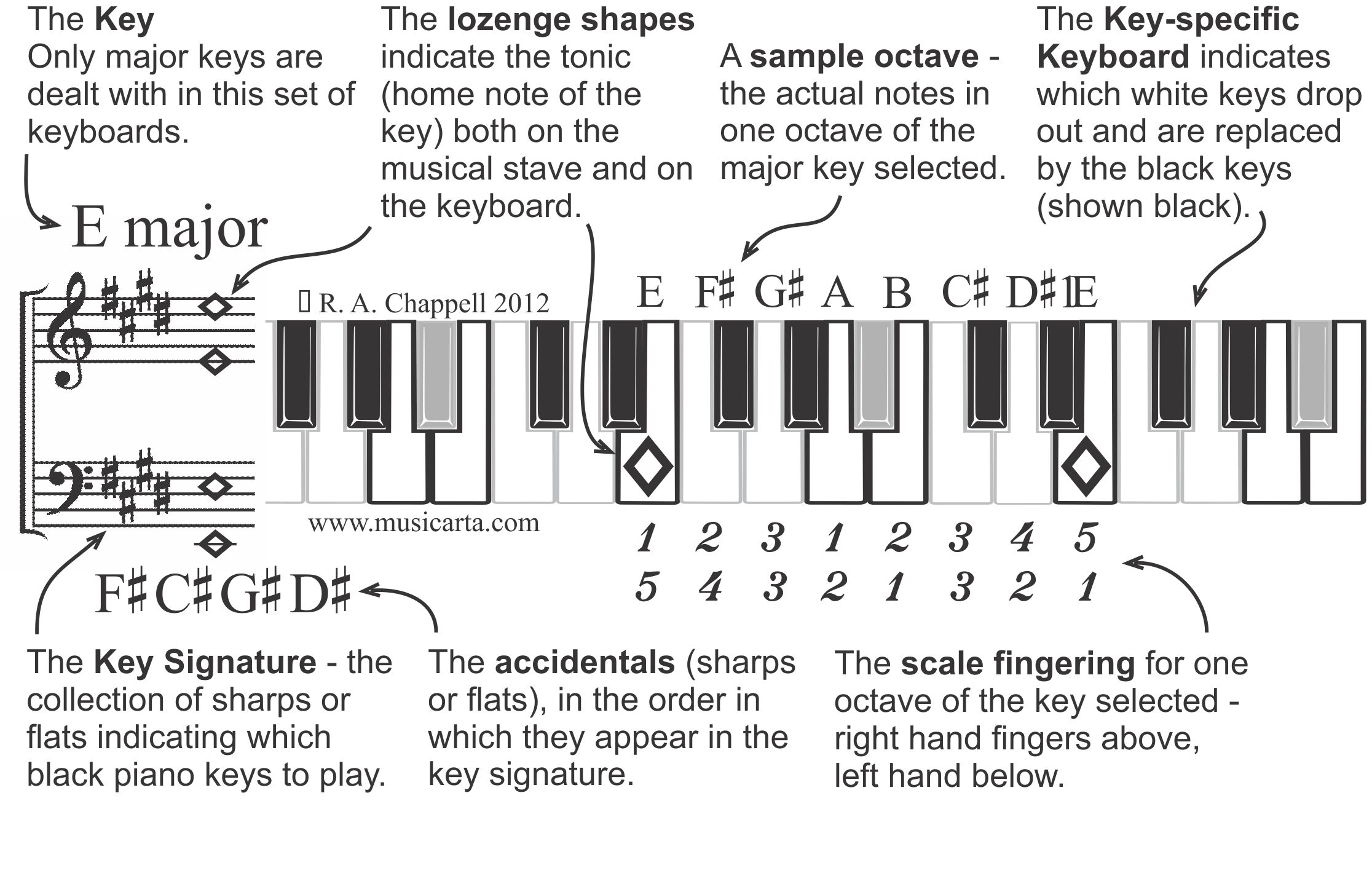
The diagrams show first 'the key' in text (C major, F major etc.). Below that is the piano stave (treble and bass clef) showing the key signature sharps or flats. Below that is a list of the sharps or flats in the key signature, in text.
The 'tonic' (home note) is indicated on the stave by the lozenge shapes. This same lozenge shape indicates the tonic on the keyboard with, too. On the demonstration ‘key-specific’ keyboard illustration, the white keys that are played in the key are shown with a strong outline – as they are replaced with the black keys indicated in the key signatures, they are greyed out. The black keys belonging to the key signature illustrated are shown in black; you do not play the greyed-out black keys.
There is a demonstration octave on the keyboard. Above the keyboard you see the names of the notes in one full octave of the key in question – the scale tones of that key. Below the keyboard is the one-octave scale fingering, the right hand above the left hand.
The illustrations are © copyright R A Chappell. You may reproduce these diagrams for non-commercial, private study purposes only. Removing the Musicarta branding is breach of copyright.
The progression of key signatures
Classical musicians are usually introduced to key signatures in an overall easy-to-hard/simple-to-complex order, but often without any overall perspective on the build-up of accidentals in the key signatures being given. It is assumed that the logic of key signature progression will somehow 'sink in'.
This ad hoc way of proceeding is not efficient. An overview of key signature, divorced from actual pieces and studied on its own, is easily presented, speeds learning, and puts appreciation of 'key' on a firm footing.
Some valuable understanding of key signature can be absorbed by simply looking through the progressive series of sharp and flat keys, without further explanation. Sharps and flats accumulate regularly and logically as we progress round the circle of fifths - sharps in one direction, flats in the other, and this can be appreciated (learned) intuitively..
The actual rule behind the accumulation of accidentals (sharps and flats) is spelled out in detail before the cumulative series of keyboard.
The sharp keys
The accumulation of sharps
The sharps accumulate as roots fall a perfect fourth: C major has no sharps, G major (down a perfect fourth) has one sharp, D major (down a fourth again) has two sharps, and so on.
The sharps ‘carry over’ into the new key. The new sharp is required to bring the seventh note of the new scale up a semi-tone to only a semitone below the tonic. Thus, F sharp is the key signature for G major. The F sharp carries over into two-sharp D major (down a fourth); C sharp is required to sharpen the seventh and form a major scale.
This means that the tonic of a major sharp key is always a semitone above the last sharp in the key signature.
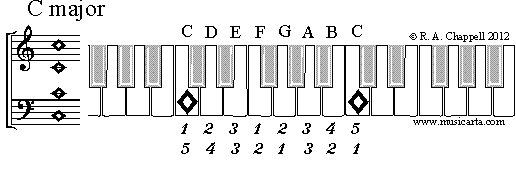
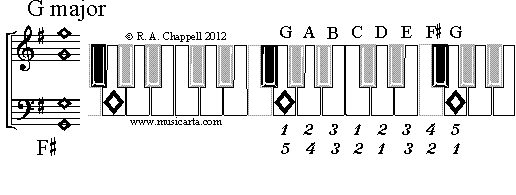
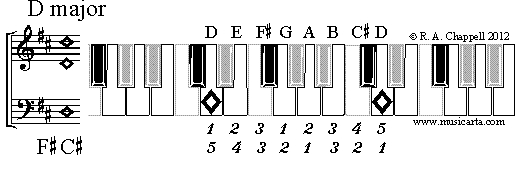
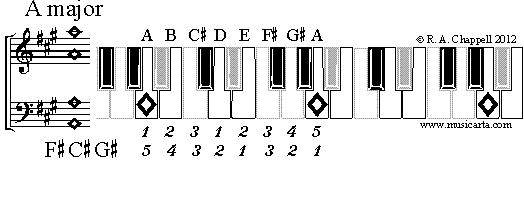
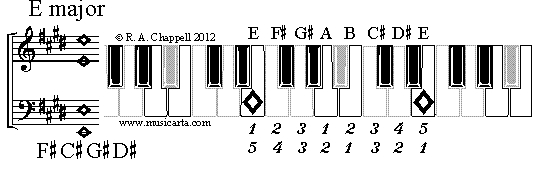
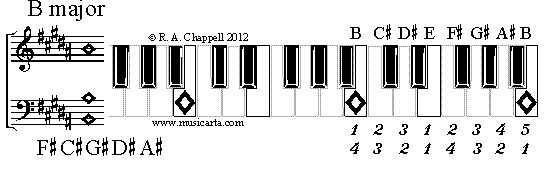
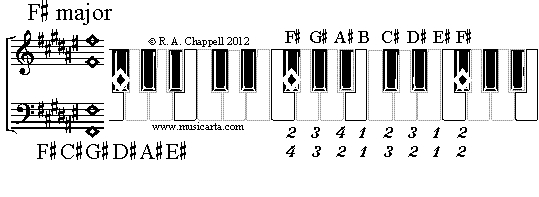
The flat keys
The accumulation of flats
The flats accumulate as roots fall a perfect fifth: C major has no sharps, F major (down a perfect fifth) has one flat, B flat major (down a fifth again) has two flats, and so on.
As with the sharps, the flats ‘carry over’ into the new key. The new flat is required to lower the fourth note of the new scale a semi-tone to a perfect fourth above the tonic. Thus, the single B flat is the key signature for F major. The B flat carries over into B flat major (down a fourth); E flat is required to lower the new fourth a semitone and so form a major scale.
This means that the tonic of a major flat key is always a perfect fourth below the last flat in the key signature.

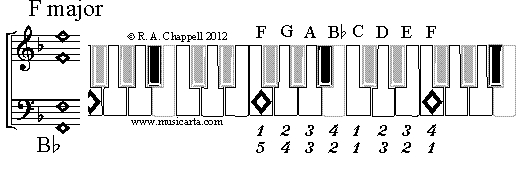
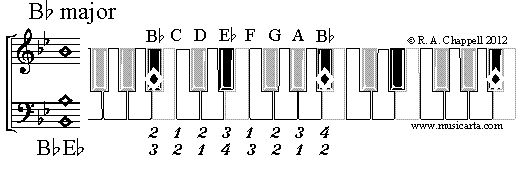
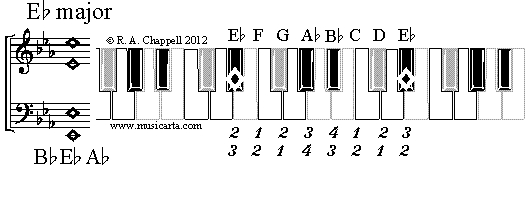
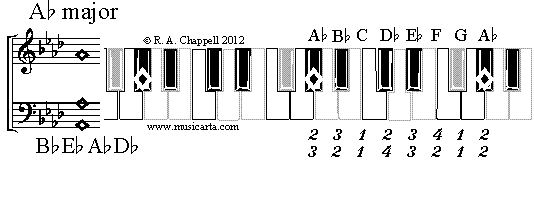
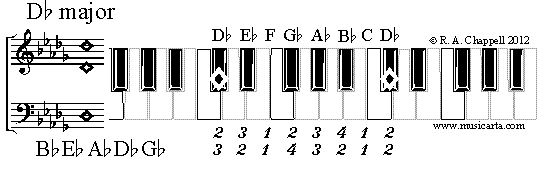
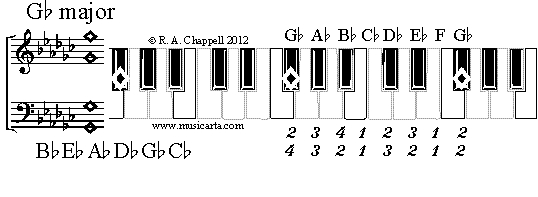
General observations
Accumulation of sharps/flats:
- Sharps accumulate as roots rise a fifth/fall a fourth.
- Flats accumulate as roots fall a fifth/rise a fourth.
Accidentals in key signatures accumulate in a certain order.
- Sharps: F sharp, +C sharp, +G sharp, +D sharp, +A sharp, +E sharp.
- Flats: B flat. +E flat, +A flat, +D flat, +G flat, +C flat.
So, if there are two sharps in a key signature (for example), they are always F sharp and C sharp. Musicians should not have to count the lines and spaces to establish this!
Another helpful rule:
- The tonic of a major sharp key is always a semitone above the last sharp in the key signature.
- The tonic of a major flat key is always a perfect fourth below the last flat in the key signature.
|
Musicarta Patreon
SCALES SERIES
Reference
Scale fingering
Scale Practice Patterns (SPPs)
Scale-tone practice patterns (STPPs)
Chromatic Scales
Diminished Scales
|
The MusicartaA methodical approach to keyboard syncopation for
|
PUBLICATIONS
exciting keyboard
creativity courses
CHORDS 101
WORKBOOK

~HANON~
video course

Musicarta
Patreon
PENTATONICS
WORKBOOK
video course

Creative Keyboard
video course

BEAT AND RHYTHM
WORKBOOK

- Volume 1 -

12-BAR PIANO
STYLES WORKBOOK

MUSICARTA MODES
WORKBOOK

PIANO STYLE

CANON PROJECT
video course

VARIATIONS
video course


- Piano Solo -
video course

- Piano Solo -


YouTube playlists





 THE LOGO
THE LOGO
